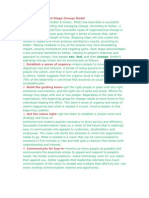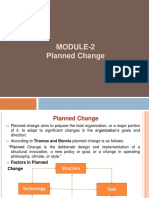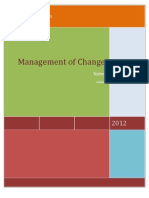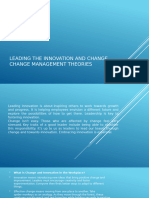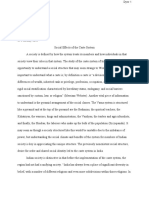0 ratings0% found this document useful (0 votes)
1 viewsMODULE5OB
MODULE5OB
Uploaded by
Priyansu NayakCopyright:
© All Rights Reserved
Available Formats
Download as DOCX, PDF, TXT or read online from Scribd
MODULE5OB
MODULE5OB
Uploaded by
Priyansu Nayak0 ratings0% found this document useful (0 votes)
1 views2 pagesCopyright
© © All Rights Reserved
Available Formats
DOCX, PDF, TXT or read online from Scribd
Share this document
Did you find this document useful?
Is this content inappropriate?
Copyright:
© All Rights Reserved
Available Formats
Download as DOCX, PDF, TXT or read online from Scribd
Download as docx, pdf, or txt
0 ratings0% found this document useful (0 votes)
1 views2 pagesMODULE5OB
MODULE5OB
Uploaded by
Priyansu NayakCopyright:
© All Rights Reserved
Available Formats
Download as DOCX, PDF, TXT or read online from Scribd
Download as docx, pdf, or txt
You are on page 1of 2
MOUDLE 5
1.Kotter’s Eight-Step plan for Implementing Change
Kotter (1995) summed up what he perceived as the essential 8 step process for
successful organisational transformation. Again, as with other models, one can
notice some similarities like creating a clear vision, conducting good
communication regarding the new vision, empowering employees, leading by
example and celebration of successes. Think about which model suits you best,
when using the change management process and adopt them in a logical
fashion.
Kotter’s defined 8 step processes are as follows:
1. Establish a sense of urgency: Examine market and competitive realities.
Identify and discuss crises, potential crises or opportunities. Create the catalyst
for change.
2. Form a powerful coalition: Assemble a group with enough power to lead
the change efforts: Develop strategies for achieving that vision.
3. Create a Vision: Create a vision to help direct the change effort. Develop
strategies for achieving that vision.
4. Communicating the Vision: Using every channel and vehicle of
communication possible to communicate the new vision and strategies. The
guiding coalition teaching new behaviours and leading by example.
5. Empowering others to act on the vision: Removing obstacles to change.
Changing systems or structures that seriously undermine the vision.
Encouraging risk taking and non-traditional ideas, activities and actions.
6. Planning for and creating short term wins: Planning for visible
performance
improvement. Recognising and rewarding employees involved in these
improvements.
7. Consolidating improvements and producing still more change: Using
increased credibility to change systems, structures and policies that don’t fit
the vision. Hiring, promoting, and developing employees who can implement
the vision. Reinvigorating the processes with new projects, themes and change
agents.
8. Institutionalising new approaches: Creating the connections between
new behaviours and corporate successes. – Developing channels to ensure
Leadership development and succession.
2.Kurt Lewin’s – Three Step Model
Step 1: Unfreezing Static Organization Structure and Implement
Change
Unfreezing is to move from status quo, which is called equilibrium, to
something like
organizational chaos. Employees like the equilibrium because they have a
sense of comfort, they know what to expect, and there is no change happening.
When the unfreezing process happens change is making the organization
turbulent and employees can become resistant .This is the most complicated
step, to get employees to unfreeze behaviour and accept change.
Unfreezing happens in three ways: 1. Driving forces: Behaviours that
contradict status quo
is increased. These behaviours are the behaviours that help employees learn
about the
change and the new processes.
2. Restraining forces: These behaviours support the status quo and contradict
change. The restraining forces need to be decreased.
3. Driving forces and restraining forces can be mixed together to illustrate that
change within the
organization will work and is good.
Step 2: Movement through Change: Employees may be confused at the
movement step of
Lewin’s Model. This confusion stems from having to learn new habits, skills, and
processes because change is being implemented .At the movement step
managers need to be good leaders and help support their employees.
Managers need to support employees if they want the change they are working
for to stay within the organization long term. Managers need to know that
change must happen fast within an organization to be successfully
implemented.
Step 3: Refreeze the Organization: The Refreezing step helps reestablish
stability and
equilibrium with the new change. The employees now have the new skills,
knowledge, and
understand why the change was implemented within the organization. This
step helps
employees go back to their normal and stable environment where they are
comfortable.
You might also like
- He Koronga Matua Na Puhaanga - Ngati Mahanga The Lands of Hamilton WestDocument27 pagesHe Koronga Matua Na Puhaanga - Ngati Mahanga The Lands of Hamilton Westapi-35202315390% (10)
- ADB Standard Lease Contract - 18 February 2014Document8 pagesADB Standard Lease Contract - 18 February 2014AP Manila100% (1)
- Yan, J.H. & McCullagh, P. (2004) - Cultural Influence On Youth's Motivation of Participation in Physical Activity. Journal of Sport Behavior. 27. 378-390.Document14 pagesYan, J.H. & McCullagh, P. (2004) - Cultural Influence On Youth's Motivation of Participation in Physical Activity. Journal of Sport Behavior. 27. 378-390.Anton SisonNo ratings yet
- Change Management TheoriesDocument114 pagesChange Management TheoriesEdison B. BuenconsejoNo ratings yet
- John Rolfe, Peter Troob - Monkey Business - Swinging Through The Wall Street Jungle (2000, Warner Books) - Libgen - lc-1Document144 pagesJohn Rolfe, Peter Troob - Monkey Business - Swinging Through The Wall Street Jungle (2000, Warner Books) - Libgen - lc-1c5875670No ratings yet
- Judicial-Affidavit-for-Murder-Case 2 PDFDocument3 pagesJudicial-Affidavit-for-Murder-Case 2 PDFmay100% (3)
- Final Module 6Document13 pagesFinal Module 6Suraj ReddyNo ratings yet
- Models of Change Change ManagemntDocument20 pagesModels of Change Change ManagemntShehnaz Khan100% (1)
- John Kotter's EightStage Change ModelDocument4 pagesJohn Kotter's EightStage Change ModelKunal JadhavNo ratings yet
- A Presentation On Organizational Change ModelDocument16 pagesA Presentation On Organizational Change ModelKunwar Ajeet Singh Baghel91% (11)
- Change ManagementDocument19 pagesChange ManagementPranjalNo ratings yet
- Lecture No 14 Date 14Document5 pagesLecture No 14 Date 14Saboor BalochNo ratings yet
- Change ManagementDocument27 pagesChange ManagementJitender Sharma Jaipuria NoidaNo ratings yet
- Q A On Change ManagementDocument9 pagesQ A On Change ManagementAnonymous v5QjDW2eHxNo ratings yet
- A Presentation On Organizational Change ModelDocument11 pagesA Presentation On Organizational Change ModelSwathi GrsNo ratings yet
- Factsheet - Theories of ChangeDocument3 pagesFactsheet - Theories of ChangeGabriel ANo ratings yet
- Materi 2.3. The Kotter ModelDocument5 pagesMateri 2.3. The Kotter ModelSiska Indria YuniartiNo ratings yet
- HRM Module 6 2021Document23 pagesHRM Module 6 2021ನಂದನ್ ಎಂ ಗೌಡNo ratings yet
- Organization DesignDocument5 pagesOrganization Designharish chandraNo ratings yet
- Lewin's Change Management ModelDocument5 pagesLewin's Change Management Modelsamyukta choudhury100% (1)
- Content of ResearchDocument10 pagesContent of ResearchYousef QuriedNo ratings yet
- Change Management OverviewDocument6 pagesChange Management OverviewpejaaNo ratings yet
- MCSIDocument8 pagesMCSISatyajeetNo ratings yet
- SID#: 1031425/1 Module: Organizational Behavior: Edition P 662)Document10 pagesSID#: 1031425/1 Module: Organizational Behavior: Edition P 662)Karen KaveriNo ratings yet
- MOC NotesDocument8 pagesMOC NotesVenkat RajuNo ratings yet
- Change Management: Yatin Kumar Preet Ratan SinghDocument24 pagesChange Management: Yatin Kumar Preet Ratan SinghyatinNo ratings yet
- 4 Types of Change Management For OrganizationsDocument10 pages4 Types of Change Management For OrganizationsFatima HadzriaNo ratings yet
- 18Document7 pages18Rajni KumariNo ratings yet
- Implemetation ChangeDocument30 pagesImplemetation ChangeSingh DhaliwalNo ratings yet
- Individual Assignment On Change MGT BirhanDocument6 pagesIndividual Assignment On Change MGT BirhanBro38867No ratings yet
- Strategic ChangeDocument4 pagesStrategic ChangeKŕiśhñą ŚińghNo ratings yet
- Change ManagementDocument13 pagesChange ManagementMilind RaghuvanshiNo ratings yet
- John Kotter On Transforming EffortsDocument1 pageJohn Kotter On Transforming EffortsAmberNo ratings yet
- Using Organizational Development Models To Improve Change ManagementDocument22 pagesUsing Organizational Development Models To Improve Change Managementsameh esmatNo ratings yet
- BSBLDR811 - Lead Strategic TransformationDocument8 pagesBSBLDR811 - Lead Strategic Transformationbobsomu0001No ratings yet
- Models of Change ManagementDocument12 pagesModels of Change ManagementkiranaishaNo ratings yet
- 8 Step Problem Solving PDFDocument2 pages8 Step Problem Solving PDFgeorgiana vasileNo ratings yet
- 8 Step Problem SolvingDocument2 pages8 Step Problem SolvingsonurehalNo ratings yet
- Top 8 Concepts For Change Management TheoryDocument20 pagesTop 8 Concepts For Change Management TheorySankari SNo ratings yet
- Change Management GurusDocument2 pagesChange Management Gurusfathima.ahamed1926No ratings yet
- Module - 2: Organizational Change and ODDocument28 pagesModule - 2: Organizational Change and ODHai DeepuNo ratings yet
- THE NATURE OF PLANNED CHANGE-DoreenDocument27 pagesTHE NATURE OF PLANNED CHANGE-DoreenTusingwire DoreenNo ratings yet
- Assessment Coursework Guide For Criteria 1 UGB371Document6 pagesAssessment Coursework Guide For Criteria 1 UGB371Jassny Pey FangNo ratings yet
- Change Activation Guide To Change Management ModelsDocument26 pagesChange Activation Guide To Change Management Modelsananth999100% (4)
- Module 3 and Module 4 AmizoneDocument69 pagesModule 3 and Module 4 AmizoneNikita SangalNo ratings yet
- MC Lecture 6 Change Models & Theories 1sem22Document26 pagesMC Lecture 6 Change Models & Theories 1sem22Sonuj8No ratings yet
- Organisation Development Change and Od Interventions 151681893850616Document27 pagesOrganisation Development Change and Od Interventions 151681893850616Mantry PriyatheeNo ratings yet
- Kotter's ModelDocument20 pagesKotter's ModelDennis Revillas100% (1)
- The Nature of Planned ChangeDocument5 pagesThe Nature of Planned Changeفیضان محبوبNo ratings yet
- Module - 4 - Organisaional DelopmentDocument4 pagesModule - 4 - Organisaional DelopmentGuru Nanak First Grade CollegeNo ratings yet
- OD and Change AssignmentDocument16 pagesOD and Change AssignmentUsmanNo ratings yet
- Organizational ChangeDocument34 pagesOrganizational ChangeAmit KumarNo ratings yet
- 3change Models andDocument16 pages3change Models andnoureldinfatmaNo ratings yet
- Organizational Change and DevelopmentDocument37 pagesOrganizational Change and DevelopmentSujan BhattaraiNo ratings yet
- A Presentation On Organizational Change ModelDocument4 pagesA Presentation On Organizational Change ModelSandeepHacksNo ratings yet
- Kotters 8 Steps-Short and TextDocument11 pagesKotters 8 Steps-Short and Textweqaqoo11No ratings yet
- Leading The Innovation and ChangeDocument21 pagesLeading The Innovation and Changekedarnath0046No ratings yet
- John Kotter 8 StepsDocument1 pageJohn Kotter 8 Stepssanna097No ratings yet
- BSBINN601 Lead and Manage Organisational ChangeDocument23 pagesBSBINN601 Lead and Manage Organisational ChangeTuba Mirza72% (18)
- Change Notes 4Document8 pagesChange Notes 4hadiasiddiquiNo ratings yet
- John Kotter - Leading ChangeDocument4 pagesJohn Kotter - Leading ChangeConstantin AdrianNo ratings yet
- Organizational Change ApprochesDocument2 pagesOrganizational Change ApprochesJahangir KhanNo ratings yet
- The Power of Habit Stacking: Change Management and Organizational ChangeFrom EverandThe Power of Habit Stacking: Change Management and Organizational ChangeNo ratings yet
- Change Management For Managers: The No Waffle Guide To Managing Change In The WorkplaceFrom EverandChange Management For Managers: The No Waffle Guide To Managing Change In The WorkplaceRating: 3.5 out of 5 stars3.5/5 (6)
- Prayer: Direct Dial To Heaven: Chapter ThreeDocument15 pagesPrayer: Direct Dial To Heaven: Chapter ThreeBillNo ratings yet
- Images of Nurses in MediaDocument8 pagesImages of Nurses in MediaRufus Raj50% (2)
- Final Case Study FM 108Document6 pagesFinal Case Study FM 108Jeff Beloso BasNo ratings yet
- Emerging Trends in HRMDocument13 pagesEmerging Trends in HRMHimanshu Goel100% (2)
- English OlympiadDocument5 pagesEnglish OlympiadZakir Hossain50% (2)
- 2021 Business Studies Grade 10 Step AheadDocument181 pages2021 Business Studies Grade 10 Step Aheadjulieann pillayNo ratings yet
- سيرة روفائيل الطوخيDocument2 pagesسيرة روفائيل الطوخيGeorge FahmyNo ratings yet
- Unit 4. Ethnic Groups of Viet NamDocument12 pagesUnit 4. Ethnic Groups of Viet Namquynguyenn0405No ratings yet
- Cook County Grand Jury R. Kelly IndictmentDocument36 pagesCook County Grand Jury R. Kelly IndictmentEllyn Santiago100% (1)
- Exchange Control Act 1953 (Act 17)Document58 pagesExchange Control Act 1953 (Act 17)Adam Haida & CoNo ratings yet
- PCCS at Vendor 12dec19Document28 pagesPCCS at Vendor 12dec19Deepak Tewatia100% (1)
- IncompatibleDocument31 pagesIncompatibleSistemas ArmeniaNo ratings yet
- Session 2 DGR Table 2.3ADocument2 pagesSession 2 DGR Table 2.3AAnkita Mukherjee100% (1)
- County of Santa Clara Local Rules of Court 2022Document118 pagesCounty of Santa Clara Local Rules of Court 2022Daya BaranNo ratings yet
- Vacancy Notification Circular CEO CBFC - 2023Document6 pagesVacancy Notification Circular CEO CBFC - 2023Kamaraj JayaramanNo ratings yet
- Maya To Aztec - Ancient Mesoamerica RevealedDocument353 pagesMaya To Aztec - Ancient Mesoamerica RevealedMusic SimpleNo ratings yet
- 1.intro To Ethical HackingDocument5 pages1.intro To Ethical HackingSachin SharmaNo ratings yet
- National Stock Exchange'S Certification in Financial Markets (NCFM)Document4 pagesNational Stock Exchange'S Certification in Financial Markets (NCFM)Saran BaskarNo ratings yet
- 6019SSL CW2Document18 pages6019SSL CW2Muhammad Salman KhanNo ratings yet
- Kylee Dyer - Social Effects of The Caste SystemDocument6 pagesKylee Dyer - Social Effects of The Caste Systemapi-512401228No ratings yet
- Cit0007e 2Document1 pageCit0007e 2anas jbainNo ratings yet
- FortiSandbox-4 2 3-Administration - GuideDocument238 pagesFortiSandbox-4 2 3-Administration - GuideForTest TestForeNo ratings yet
- Term Paper Group 4 - Local ElectronicsDocument21 pagesTerm Paper Group 4 - Local ElectronicsLabib Irfan ChowdhuryNo ratings yet
- Dwarka Expressway Gurgaon: Peripheral Road (NPR), The Expressway Will Soon Be A Reality. in ThisDocument21 pagesDwarka Expressway Gurgaon: Peripheral Road (NPR), The Expressway Will Soon Be A Reality. in ThisSaanchi r100% (1)
- Siti Wulansari, DR.: Academic History About MeDocument1 pageSiti Wulansari, DR.: Academic History About MeWulansari Jude AnwarNo ratings yet








